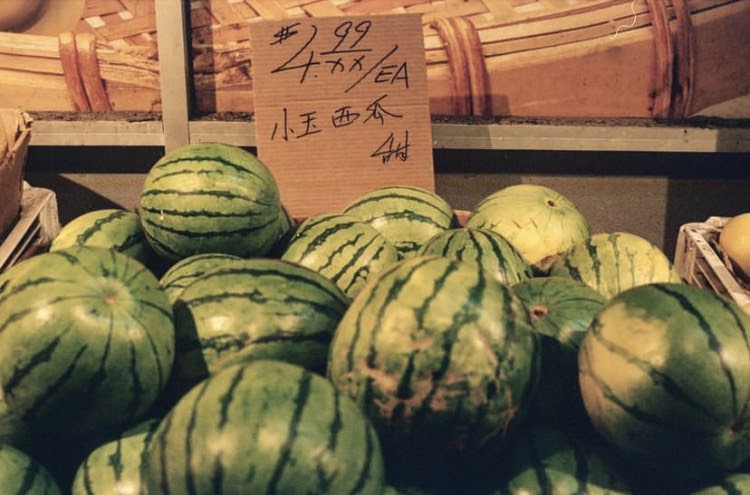The Joy of Asian Supermarkets
After accompanying my father on trips to our local Asian supermarkets, I have developed a fondness for the exotic dragonfruit, for the low ceilings, and for beady-eyed fish.
A crate of watermelons sits outside; my father would often slap them to decide which ones were ripest.
When people think of ‘fun places to visit,’ supermarkets do not come to mind; but for me, true happiness is walking into a Jmart and picking out a box of Melona ice cream bars to savor on the car ride home.
My father goes grocery shopping often, and despite hauling what looks to be a week’s worth of food home, he takes a trip back to the store every other day. It has turned into a tradition to race down the stairwell to weight lift those distinct red plastic bags into the kitchen.
On the occasion that my family spends the day in Flushing, whether it’s going to the doctors’ office, the SkyView Center Mall, or for Dim Sum, we unfailingly head to the closest Asian grocery store at the end of the day. There’s something nostalgic about stepping foot into one. Perhaps it’s the fact that it is always the last stop before we return to our mundane routines, but I like to think that the answer lies in the ambiance.
Asian supermarkets vary depending on the location, but they all have similar layouts. A regular at one store will know what to expect at virtually any other branch. Lined up near the front entrance are fruit stands with rows of unpackaged apples, cherries, and watermelons which flaunt themselves to pedestrians. I’ve long since questioned how the store owners are not afraid of their goods getting stolen, but I think that it is a testament to how much they trust the community.
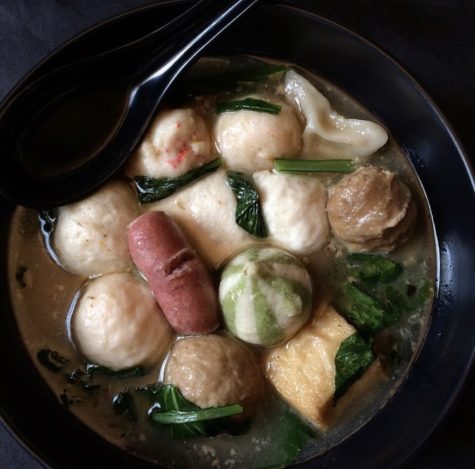
Unlike American grocery stores that advertise online, my local Asian grocery stores mainly serve their neighborhood. On the walls and at the cash register are community notices like reminders to vote for a council member, announcements regarding tutoring programs, or updates on legislation. Visits are a lot more than a weekly stop to fill one’s refrigerator with food, but also a gathering of individuals who share heritage and taste buds. I can already see the Chinese aunties congregating near the amaranth greens as if it were a reunion, conversing for hours while also searching for the ingredients for tonight’s dinner.
I was astonished when I discovered that establishments like BJs, Costco, and Sam’s Club were considered supermarkets due to their sheer size, but even traditional chains like KeyFoods have a refined quality to them. The waxy unbruised apples, lighting fit for movie sets, the wide footpaths, and the carefully stacked Goya bean cans appear superficial. Even the price tags are polished in their neat laminated fonts when set side by side with the hand-scrawled labels of some Chinese groceries.
Upon entering an Asian supermarket, the first thing that catches people’s attention is the tanks of live seafood. While it might be startling for outsiders to see the octopus, oysters, and squid swimming lazily to and fro in tanks, it is commonplace for Asian-heritage shoppers. The lobsters and larger fish are suspended in the transparent teal-tinted tanks, packed together so tightly that it probably breaks some maximum occupancy law.
On the counter are display cases of smooth, thick filets of salmon and long beady-eyed beltfish. Directly in front, lining the footpath of the seafood section are open Styrofoam boxes with smaller catches like snails, sea cucumbers, and jellyfish.
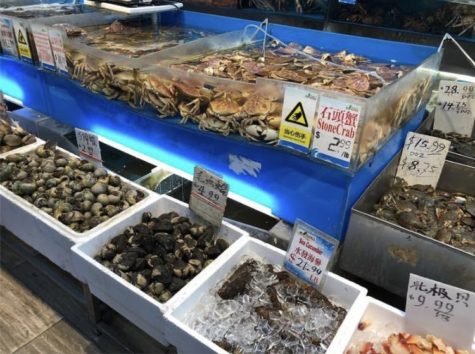
Seafood is a crucial aspect of Asian cuisine, so freshly imported fish is always in stock. One can expect to find a fishmonger standing to the side, ready to scale and bag each item. Although the smell is off-putting for some, I find it comforting. The familiar scent remains unchanged since I first stepped foot into a supermarket at the age of five. The salty notes of the ocean, iron, and algae is what I imagine lingering around fish markets near local docks.
It is my favorite section largely due to the “liveliness” of the seafood. I enjoy watching the stone crabs fittingly using each other as stepping stones to scale the glass cases in a last-ditch effort to escape the steaming wok. Those who have surrendered to their fate lay lazily at the bottom which is ironically the smarter move — because they are picked last.
The ones which still hold the futile hopes of making it miles back to the ocean are extra feisty. At SkyFoods Supermarket, I had the pleasure (or displeasure) of meeting the sassiest crab. As I approached, it sashayed its way towards the edge of the box. It then dramatically extended its large pinchers and started snapping the air as if to ward me away.
The shrimp, although less entertaining, are also fun to observe. Occasionally, one jumps two or three inches into the air, writhing, only to land back in its original position. I’m convinced that the shrimp believe that if they jump high enough, they may eventually find a way to ascend out of the supermarket.
While the meat section (thankfully) does not offer live meat, it is also special due to its less common cuts, and offerings of offals and organs.
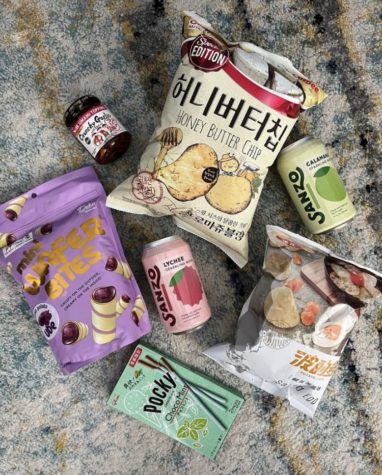
The snack aisle is undoubtedly the most popular. As a kid, I could spend hours staring longingly at the shelves of seasoned nori, Choco Pie chocolate-covered marshmallow cakes, and boxes of Pocky sticks. Although bags of Doritos are also available, why not try combinations that would never be found elsewhere? Where else could one try fish-shaped Taiyaki ice cream with red bean filling, wasabi green peas, or grilled eel-flavored Lay’s chips? Despite my sixteen years of snacking, I have yet to try every item in that aisle.
Michelle, a patron at 99 Ranch Market explains, “I feel connected to my heritage every time I go. Sometimes I find foods that I ate while traveling in Asia at these stores which bring back happy memories. Not only that, but most of the time produce and meats are cheaper than those I find in American stores. There are also many items that are unique to Asian groceries: Chinkiang Vinegar, Korean melons, persimmons, fish balls, and a soy sauce brand although I can’t recall the name (Lee Kum Kee?).”
Although there have been more English labeling in recent years, most of the packaging is still written solely in their native language; so, unless one has family or friends who are well versed in those languages, it’s a gamble to blindly purchase something.
With my nonexistent Chinese skills, I have a lot of fun guessing the foods, especially when there is little visual aid on the cover. For instance, there is the “Corn Soup Flavor: Crunchy triangle!” and “New! STRONG” for what I assume to be a bag of grilled seafood potato chips. We also have the occasional mistranslation fail such as “Child shredded meat: delicious classic” for a container of pork floss. Half of the fun is seeing what new snack catches one’s eye, especially when all the colorful wrapping is vying for attention.
For new shoppers, it may be difficult to find the items on their grocery list. While SkyFoods Supermarket has the typical overhead “Section 3: Spices” banner, most other grocery stores rely on well-seasoned customers to know the layout. The seafood, meat, and frozen goods sections are easy to find, but everything else is located someplace in the middle. This has led to some interesting discoveries like pickled garlic, because only God knows how much garlic is needed for a single dish.
During important Asian celebrations like Lunar New Year, the supermarkets are decked out with more red than the eye can see. Dim lanterns hang low on the ceilings and foods that promise to bring customers longevity and fortune adorn the shelves. At the checkout, there are free zodiac-themed timetables with the lunar calendar on them. Likewise, when the Mid-Autumn Festival rolls around, boxes of mooncakes line the walls, which my family readily buys to send to relatives.
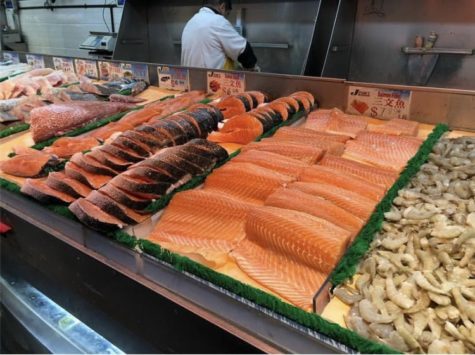
In a country of vibrant multiculturalism, food acts as an integral cultural ambassador. Ethnic supermarkets are one element among many that factor into the American identity. Rich Sanders, an ethnic food blogger on Instagram, shares, “Going to an Asian supermarket — any international food market actually — is a passion of mine. One thing that we all have in common regardless of where we live on the planet is the need to eat; but what we eat is informed by our geography, our climate, and our culture – and that’s where the fun begins. There’s so much to learn from each other, so much to experience, and in my opinion, sharing our cuisines is the best place to start. Because I’m a world music and language nerd as well, even just walking through the aisles listening to the ambient music and reading labels is an enlightening experience.”
So, I urge you. On your next trip to a supermarket, why not visit a Jmart, H Mart, Chung Fat, or Great Wall? A quick google search reveals that there are locations less than a mile away. And who knows, maybe you can tell me what the “Corn Soup Flavor: Crunchy triangle!” is.
Rich Sanders shares, “Because I’m a world music and language nerd as well, even just walking through the aisles listening to the ambient music and reading labels is an enlightening experience.”
Nicole Zhou is the Editor-in-Chief for ‘The Observatory' yearbook and a Staff Reporter for 'The Science Survey' newspaper. This is her third year revising...

